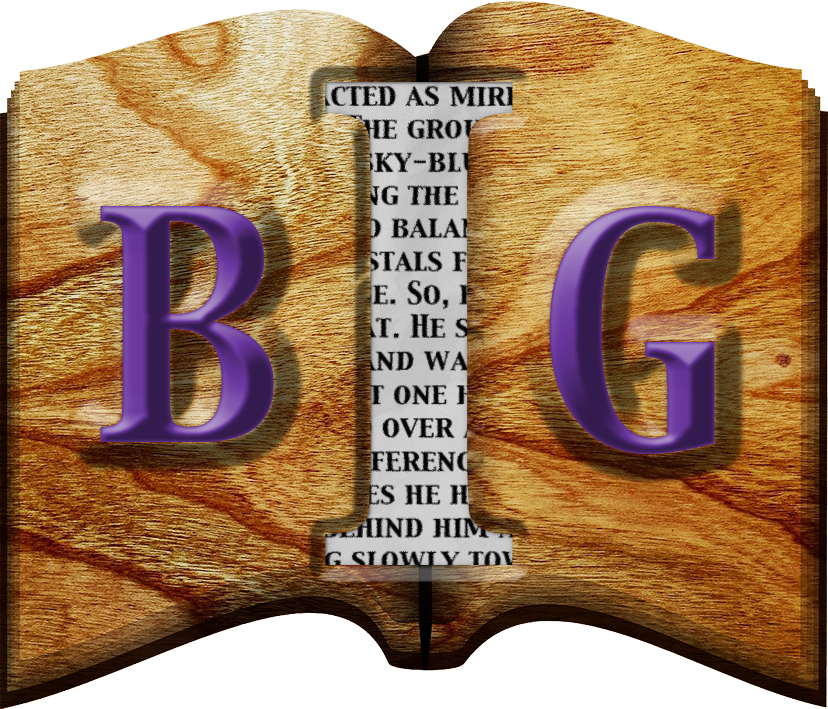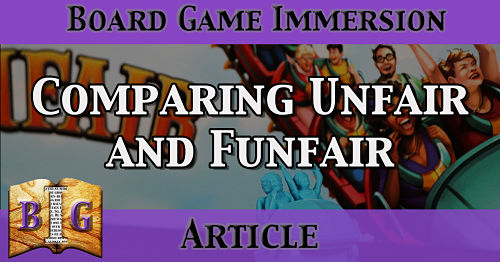The game Unfair from Good Games Publishing has been around for a while now, but Funfair had a relatively quiet release, probably due to COVID-19 slowing down production and delivery. In this article, we’re going to take a look at both Unfair and Unfair and compare the two. Personally, I really like both games, and for various reasons. Plus, these games are quite photogenic! So let’s get started with our comparison of Unfair and Funfair!
Complexity
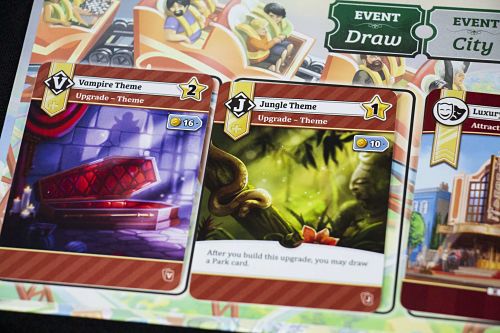
Some games are easy to learn, whereas others require more dedication. While Unfair and Funfair are very similar games, they do have different levels of difficulty.
Unfair
Unfair can be rather intimidating upon first glance. Lots (and lots) of cards, a bunch of different theme decks to choose from (with more in the expansion—which is excellent, by the way). Fortunately, the rule book is well written and simple to follow. Still, there’s a lot to digest. But it’s like going to Tucanos for dinner. All-you-can-eat meat, meat, and more meat! It’s delicious, it’s always welcome, and there’s a reason it’s so popular.
Each theme deck adds a varied amount of complexity, including “Unfairness,” which essentially ranges from a bit of mean stuff in the cards to you’re gonna be at each others’ throats from the start. Some themes produce more money than others, some help you get larger attractions, and other still help you focus on a blueprint (i.e. bonus end-game points) strategy. Combining these decks make for some interesting scenarios, and will certainly add to the game’s complexity, as you’re constantly seeing new cards and rethinking your strategy with each combination.
I wouldn’t say Unfair is a hard game to learn and/or play, but it certainly has its meaty moments.
Funfair
Simply stated, Funfair is a more approachable version of Unfair. Streamlined and without the “take-that” (i.e.negative player interaction) mechanic, it is an easier ride, so to speak. Without a multitude of theme decks to choose from, setup is pretty simple (shuffle and deal, more or less) and the variation from game to game is relatively the same. That said, there is still a good deal of extra life in the game (see Replayability, below).
If Unfair is Tucano’s, then Funfair is Buffalo Wild Wings. It’s delicious, and you love coming back, but it isn’t as intense. It’s way up there from McDonald’s and other fast-food joints, but there’s a class of its own that keeps you coming back for more. McDonald’s is convenient (if a little gross, personally), but B-Dubs is where you go for a good time.
With simplified—and some improved—rules, Funfair is easier to get started playing, and less intimidating than its older sibling. It plays faster than Unfair (15 minutes per player versus 25 minutes per player) and doesn’t require you to get to know a bunch of different decks, as well as combinations of said decks.
Funfair is an easier entry point than Unfair, and is probably a better option if you’re playing with people you don’t want to overwhelm or that prefer “lighter” games. Funfair isn’t exactly “light,” but it’s not as complex as Unfair.
Competitiveness

There are many types of gamers in the world, but two stand out in regards to these games. First, there’s the player who likes to compete. They like to sabotage their opponents and are OK with a little foul play directed at them in return. On the other hand, there are folks who would prefer you kept your distance and didn’t mess with their stuff. In essence, this is probably the biggest difference between Unfair and Funfair.
Unfair
Unfair practically encourages players to attack each other—close their attractions, fire their employees, and take their money. Even the City Event cards that come up toward the end of the game hurt all of the players. There’s nowhere to run, and if you don’t play a well-timed event on your opponent to take their cash (or close their rides), they’ll likely do it to you first. Unfair’s player interaction can be gritty at times, but I find that to be where a lot of the fun comes into play.
Of course, you don’t have to be ruthless in your strategy; there is an option to play without the negative interactions. Or, you can all verbally agree not to mess with each other (but we all know how that will turn out if it’s not signed in blood). I’ve played games where the back-and-forth was brutal, and games where the only bad stuff came from the City Event deck, and that happened to everyone. Really, it depends on who you play with and what rules you choose to enforce.
Personally, I like the looming threat, as it turns me paranoid and forces me to undermine them first. And then I find out they weren’t ever planning to throw a wrench in my works and I’m just a big jerk. But I’m a big jerk with a pocketful of their cash, so it’s all good.
Funfair
Funfair is for players who don’t want to look over their shoulders through every turn. There are no negative events, and players don’t even get event cards, so you don’t have to worry about them! The worst thing someone can do to you is take the card from the market that you were eying. And, chances are, they weren’t doing it to be vindictive. As it turns out, they actually needed that card. Who knew!
There is far less to say about Funfair’s player interaction and competitiveness because, well, there really isn’t that much. As far as player interaction goes, it’s keeping an eye on their parks and trying to keep up. You can be as competitive as you want, but you can’t do anything to literally rob them of victory.
If you’re looking for a peaceful game night, Funfair is where it’s at. No stress (not induced by others, at least), and no paranoia threatening to consume you. Funfair is a nice, fun ride when it comes down to it.
Emotional Impact
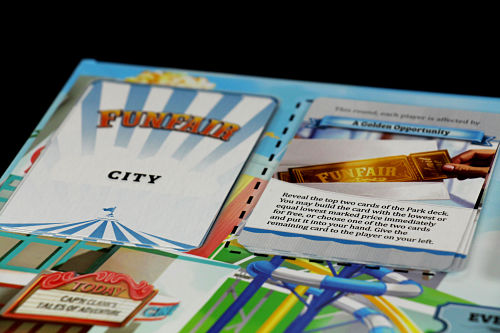
Board games can have an emotional effect on people. Whether you’re this close to flipping the table or you’re in a mild state of zen, chances are you got to this point because of your decisions and the decisions of others. Unfair and Funfair tend to be on opposing ends of this spectrum, as described here.
Unfair
As the name suggests, there’s a lot in Unfair that can get your blood boiling. Of course, it’s all in good fun (and I really do love it), but it can be frustrating when one of your attractions closes because your opponent played a nasty event card. But, you can get them back, and sweet revenge does feel good. I won’t say that Unfair won’t take its toll on some people; you know your playing style, and if people messing with your stuff is enough for you to not enjoy a game, then you may find Unfair to be a game to avoid. But, for me, the player interaction is a wonderful addition to the gameplay that really adds a kick to the experience.
Funfair
Do roller coasters make you happy? Do mean people make your emotions turn from joy to anger in a heartbeat? If you want a game void of bad feelings that includes everything Unfair has to offer, then Funfair is your game. Due to the design, there is no chance (ok, a very little chance, but that’s if you’re actively looking for something to be hurt about) to be offended by someone else’s action.
Honestly, Funfair is so easy to write about in this respect because the emotional impact isn’t the rollercoaster that Unfair is. Sure, there are ups and downs, but those come in any game. Fortunately, you don’t have to hold a lasting grudge after Funfair ends and real life commences.
Play Time
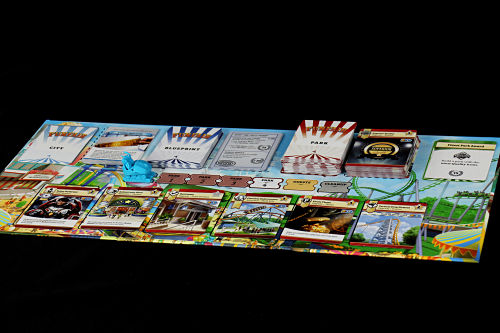
Time is money, so if a game is too long (is that even a thing?) you may not be as excited to sit down for it. Unfair and Funfair don’t differ too much in play time, but the difference is enough that it’s worthy of consideration. Essentially, Unfair takes about 25 minutes per player, and Funfair takes about 15 minutes per player. That’s a 20-minute difference at two players, or 40 minutes at four.
I will say, though, that the playtime for both games tends to be longer than what is listed on the box. Of course, that could be just who I play with and how we play, but it’s been consistent. That said, the length has never felt long, even during the longest game. It’s pure enjoyment for me, so I’m fine with however long it takes. But I’m just saying.
Gameplay Differences
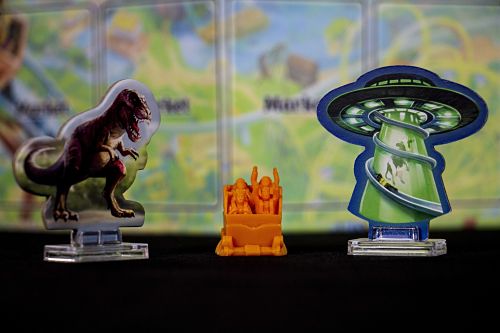
You don’t make an entirely new game if it doesn’t come with new rules and other changes, and so it is with Unfair and Funfair. There are certainly differences, and while they may not be massive, I feel like the changes were good. Instead of discussing the differences by game, I will instead break this section up by the differences and compare from there.
Theme Decks
This is probably the biggest difference of all. In Unfair, you have a choice of a handful of different theme decks. Each deck varies the way each game plays out (as mentioned above), so there’s a fair amount of thought that goes into the game before it even starts (i.e. which decks do I want to include? How will they affect the game? Do I want more of X or more of Y?).
In Funfair, however, there is only one deck of cards, and it includes four different themes. Because these are always present, you don’t get to decide which ones are in play. This is great if you are playing with new players or don’t want to separate cards before beginning.
Super Attractions
In both Unfair and Funfair, each player starts the game with a Super Attraction. These special attractions cost a heap more money than anything else in the park, but are generally worth every penny. In Unfair, you’re on your own when scrounging up the cash to play your Super Attraction. In Funfair, however, you get a little help. At the end of each round—and if you have not yet built your Super Attraction—“investors” will give you $5 to go toward your Super Attraction. The money goes on the Super Attraction card itself, and it may not be used for anything other than that attraction. If the game ends and you still haven’t built your Super Attraction, you lose all of that money.
This is a good way to get your Super Attraction at a discount—or even for free—but you still need to plan ahead to you can get the card’s full benefit for playing it. It certainly makes playing those cards easier, and when you’re new at the game and struggling to manage your money (I still struggle…), having that extra help is always appreciated. Or, you could go the Unfair route and just spend all your money on it without any help. Because pride.
Also, in Funfair, there are a total of four Super Attractions, each one its own unique theme. However, all of their abilities are the same, so it really doesn’t matter which one you’re dealt. Unfair has two Super Attractions for each theme deck, and all of the Super Attractions from all theme decks in use are shuffled together and two dealt to each player. So you have a bit more variety and flexibility in Unfair. But, in Funfair, knowing you don’t have to make a decision and, therefore, unwittingly messing up your park’s dynamic is also rather nice.
Events
Unfair and Funfair both have events, but there is one crucial difference: Funfair only has City Events. While Unfair also has City Events, it also has regular events that are played by the players. City Events affect everyone; regular events affect a certain opponent as chosen by you, the one who played the event to begin with. Of course, those regular events also give you the option of ignoring the negative effect on others and getting a positive effect for yourself, so you aren’t always targeting people. Because those regular events don’t exist in Funfair, the game is a lot friendlier and it doesn’t take as long to play, since you’re not taking the time to go through that phase of the game.
In the case of City Events, Funfair only has good, beneficial City Events. Unfair, on the other hand, has both good and bad City Events. Again, this gives Funfair the edge on friendly gameplay, but Unfair excels making your life difficult.
Park Limit
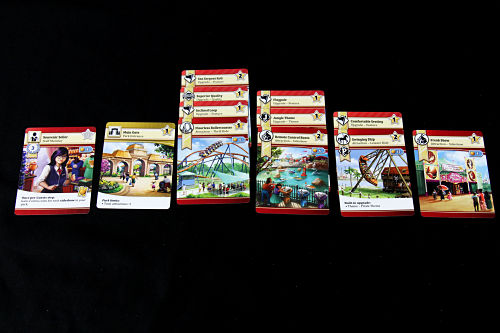
You need guests to come so you can make money, but you also need to make sure there is room for everyone that wants to come. Fortunately, Funfair’s mechanics allow everyone to come to the park! No limits here! Unfair is a bit more picky when deciding who gets to come in. The general rule in Unfair is that you cannot have more than 15 park guests in your park each round. Or, maybe you can, but any guests exceeding 15 simply get in for free, so you don’t get their money.
Either way, you really need to plan your park wisely to maximize its offerings. In Funfair, however, you can build your park any way you feel like it and you will always get paid regardless of how many guests show up! So, if you can net in 20+ people, you’re bringing in 20+ dollars for your efforts. In Unfair, you have your limit, but you have more options to take even more money from those 15 paying customers. So there’s some give and take between the two rules, but both play well and are excellent for the game they’re apart of.
Loans
In Unfair, you can take out loans if you’re struggling for cash, but you also start with only $20. On the other side, Funfair doesn’t have loans, but you start with $30 instead. Not a big difference on the surface, but the implications do set the stage for how you spend your money in each version.
Awards
While Unfair does not have any bonus awards to score at the end of the game (aside from Blueprints, which Funfair also has), Funfair has a number of Award cards that can help you focus on specific things for you park. For example, at the end of the game, the player with the “most guest services” in their park gain an additional 15 points. This could be a game changer in a close game! Besides, as I mentioned, these awards help players unfamiliar with the game work toward something, guiding them along until they can get a firmer grasp on the gameplay.
And, as mentioned, Unfair doesn’t have these Award cards. Which is probably for the best, because that would encourage even more destruction of rival parks.
Which Version is Best?
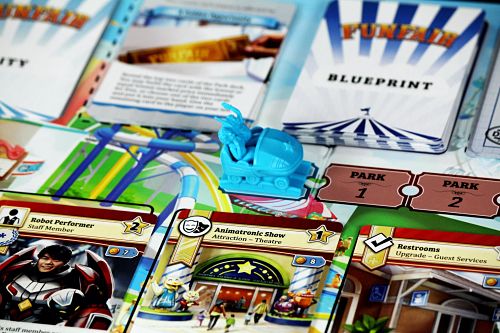
Trick question.
And I mean that. You see, both games are very good, which makes it difficult to choose a favorite. Unfair is best in some situations, whereas Funfair is better in others. And—perhaps most important of all—it comes down to your preferences, the type of gaming experience you’re looking for.
If you prefer not to have other players meddling in your affairs, then Funfair is probably more up your alley. However, if you love a game with more variety and the ability to mix games up from one to the next, Unfair is where it’s at. But now that you know the differences between the two, I’ll leave the final decision up to you.
For me, I prefer Unfair, thanks to the various theme decks and more options in gameplay. However, I’m never opposed to play Funfair should I be playing with a more reserved crowd. I have both copies, and they will both remain with me forever and ever because they both fulfill a different need.
So which is it for you, Unfair or Funfair? Share your reasons why in the comments!
Read my reviews of Unfair and Funfair at Board Game Atlas!
Funfair Review: https://www.boardgameatlas.com/forum/0VGNx6x9Da/fair-is-fair-a-funfair-review
Unfair Review: https://www.boardgameatlas.com/forum/ypEE69fZOB/a-totally-fair-review-of-unfair-and-the-abdw-expansion
Buy Unfair on Amazon (affiliate link)
